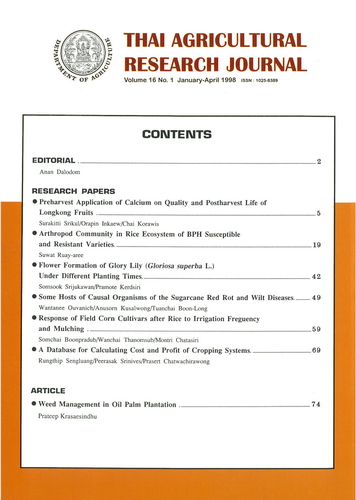Arthropod Community in Rice Ecosystem of BPH Susceptible and Resistant Varieties
DOI:
https://doi.org/10.14456/thaidoa-agres.1998.2Keywords:
Arthropod community, rice ecosystem , susceptible and resistant rice varieties to BPHAbstract
Plant characteristics affect on the arthropod community structure in the plant ecosystems. The arthropod communities associated with the BPH susceptible (RD 7 and SPR 60) and resistant (RD 23 and SPR 90) rice varieties were investigated on the structure, seasonal occurrence and the relationship of the arthropod guilds. This study was conducted in the farmer's field at Amphoe Lam Luk Ka, Changwas Pathum Thani during 1993-1995, both dry seasons and wet seasons with broadcasting rice. None of insecticide was used, and arthropods were collected weekly by D-vac machine. All arthropod samples were identified and counted the numbers under binocular microscopes. The data were then analyzed.rnThe results showed that the proportion of arthropod community structure was the same in both ecosystems. Scavengers were dominant guild of 51-58%. Diptera, the most common found scavengers, were abundant in vegetative growth of rice. The second was phytophages (17-21%). They were mostly leafhoppers and planthoppers of which th green leafhoppers, Nephotettix spp. (Honoptera, cicadellidae) was the mos tabundant (40-49%) in vegetative growth. The third were hymenoperous parasitoids. their composition to the total arthropods was 14-16% and was found mainly in the reproductive growth of rice. The last group were predators (11-12%) of which spiders possess 58-62% of their proportion and were found abundant in the reproductive growth while Cytorhinus lividipennis (Hemiptera, Miridae) represented only 31-37% and found mainly on vegetative growth.rnThe rice varieties affected on the proportion of BPH population, 19% of the BPH was found on susceptible while 11-13% of the BPH on resistant varieties. The BPH number on susceptible varieties was 1.6-2.4 times higher than resistant varieties. Obviously, Cyrtorhinus lividipennis played the role in biological control of leafhoppers and planthoppers. The competition among the natural enemies did not appear, but their population showed tendency of facilitation in biological control of the insect pests.
Downloads
Published
How to Cite
Issue
Section
License

This work is licensed under a Creative Commons Attribution-NonCommercial-NoDerivatives 4.0 International License.
Thai Agricultural Research Journal



